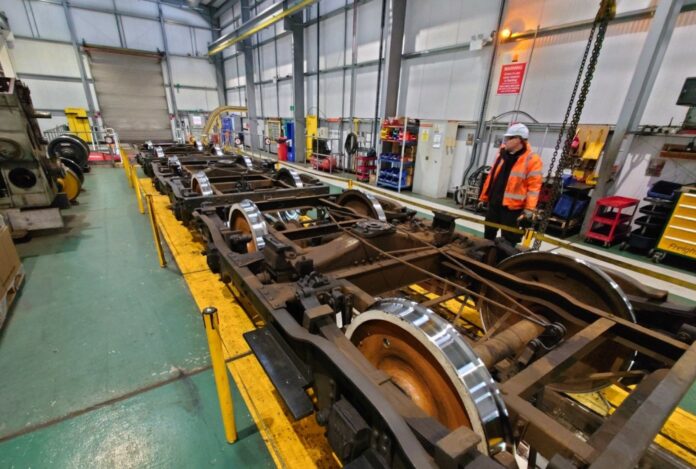Refurbishment work has been completed on North Norfolk Railway’s (NNR) 1920’s commuter carriages that will keep the 99-year-old carriages in service for years to come.
The London North Eastern Railway (LNER) 1924 Quad Articulated Set is scheduled be in action on Easter holiday services from 4 to 16 April, including during the line’s Spring Steam Gala, marking the set’s return to service following reprofiling of its tyres for the first time since its restoration approximately 15 years ago.
This latest project undertaken by staff and volunteers at the popular heritage line focused solely on the re-turning of the carriages’ tyres but because of the set’s articulated design which means the four carriages are permanently coupled together with adjacent carriages sharing a four-wheeled bogie, this was a mammoth task.
Carriage and wagon supervisor, Chris Moxon said “Splitting the sets and lifting the carriages to release the bogies was an extremely complex operation and a spare articulated bogie recently donated by the NRM was used as an accommodation bogie so we could deal with the set in two halves.
“Even then it’s not straightforward; the set only has buffing and coupling gear on the two ends so moving the half-sets had to be carefully planned” he added.
The process involved first removing all brake rigging, brake pipes and electrical connections in preparation for the separating & lifting of individual coaches, which then enabled the extraction of the carriage bogies. Lifted by M&GN Society owned crane “Horace”, itself a heritage but regularly-used road crane, the bogies were then transported to Leeds where the tyres were turned back to their correct profiles at a state-of-the art engineering facility operated by rail freight company, Freightliner.
The line’s Quad Articulated set is the only surviving example of 98 sets that were built in the 1920s and which formed the mainstay of commuter trains out of Kings Cross for around 3 decades. They were designed by Sir Nigel Gresley to address issues with the smoothness of the ride that had plagued suburban carriages since the 1880s. Using bogies improved the comfort for passengers while sharing them between carriages kept the weight and train length to a minimum – both important to give the maximum capacity for passengers on commuter trains. Typically trains ran with two sets of “Quads” to make an eight coach train, and improvements to interiors, including the addition of electric lighting, was popular with passengers.
The unique set, number 74, has always had a special place on the NNR having been acquired by the M&GN Society in 1966 for the fledging preservation project and was regularly used on the line until 1979. By this point the set was in need of major restoration and went into storage where initial preservation steps were taken, including the removal of rotten timbers. In 2001, an extensive survey was undertaken which revealed that the approximate cost of a full restoration effort would be around £500,000. Through kind donations made by private benefactors, fundraising efforts and a grant from the Heritage Lottery Fund, the target was achieved with restoration beginning in 2003 and being completed in 2008.
Managing director, Hugh Harkett, praised the efforts by the staff and volunteers in charge of the project. “The attention to detail and the immense care they have shown throughout this process has further proved the dedication of an already very hardworking team” he said. “We are very delighted to have the set back into service so that passengers can sample travel from a century ago.”
The NNR’s Easter services will feature three different trains in action each day with the “Quads” hauled by one of the line’s historic steam locomotives making four return trips on the 5½ mile line each day. Visit www.nnrailway.co.uk for further details of standard services, special events and dining trains.



































 0113 2082620
0113 2082620 info@railbusinessdaily.com
info@railbusinessdaily.com 15 Mariner Court, Wakefield WF4 3FL
15 Mariner Court, Wakefield WF4 3FL

